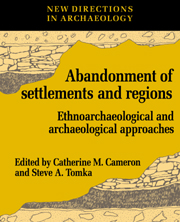Book contents
- Frontmatter
- Contents
- List of figures
- List of tables
- List of contributors
- Acknowledgments
- PART I INTRODUCTION
- PART II REGIONAL ABANDONMENT PROCESSES: ETHNOARCHAEOLOGICAL CASES
- 2 Site abandonment behavior among transhumant agro-pastoralists: the effects of delayed curation on assemblage composition
- 3 Settlement organization and residential variability among the Rarámuri
- 4 Occupational and locational instability in arid land settlement
- 5 Models of abandonment and material culture frequencies
- 6 Agricultural abandonment: a comparative study in historical ecology
- PART III REGIONAL ABANDONMENT PROCESSES: ARCHAEOLOGICAL CASES
- PART IV ABANDONMENT PROCESSES WITHIN SITES: ETHNOARCHAEOLOGICAL CASES
- PART V ABANDONMENT PROCESSES WITHIN SITES: ARCHAEOLOGICAL CASES
- PART VI CONCLUSIONS
- Index
3 - Settlement organization and residential variability among the Rarámuri
Published online by Cambridge University Press: 23 May 2010
- Frontmatter
- Contents
- List of figures
- List of tables
- List of contributors
- Acknowledgments
- PART I INTRODUCTION
- PART II REGIONAL ABANDONMENT PROCESSES: ETHNOARCHAEOLOGICAL CASES
- 2 Site abandonment behavior among transhumant agro-pastoralists: the effects of delayed curation on assemblage composition
- 3 Settlement organization and residential variability among the Rarámuri
- 4 Occupational and locational instability in arid land settlement
- 5 Models of abandonment and material culture frequencies
- 6 Agricultural abandonment: a comparative study in historical ecology
- PART III REGIONAL ABANDONMENT PROCESSES: ARCHAEOLOGICAL CASES
- PART IV ABANDONMENT PROCESSES WITHIN SITES: ETHNOARCHAEOLOGICAL CASES
- PART V ABANDONMENT PROCESSES WITHIN SITES: ARCHAEOLOGICAL CASES
- PART VI CONCLUSIONS
- Index
Summary
Introduction
Our assumptions about what we expect to see in the archaeological record influence our interpretations of that record and of the cultural adaptations we strive to understand. Understanding abandonment is a case in point. As the papers in this volume show, the term “abandonment” includes a variety of meanings and physical manifestations. Interpreting abandonment of habitations through the archaeological materials left at a site has implications at the level of the residential sites and in terms of regional settlement patterns. If we assume a single kind of abandonment in archaeological contexts, then the variations in assemblages must be interpreted along other lines – for example population, wealth, or social status. If we consider that the archaeological record may represent several different contexts for abandonment, then we can address the problem of how to distinguish between them.
Punctuated abandonment is the regular, planned movement of a household from one residence to another. The term “punctuated abandonment” implies both planned departure from and anticipated return to a residence. When regular intervals of abandonment and reoccupation are an integral part of a subsistencesettlement system, they strongly influence the kinds of goods and the organization and use of space at contemporary habitations. An ethnoarchaeological study of the Rarámuri (Tarahumara) of northern Mexico provides an example of punctuated abandonment and the resulting material assemblages expected at residences. This discussion considers how formal and distributional aspects of materials at habitations are indicative of the general settlement system of punctuated abandonment.
- Type
- Chapter
- Information
- The Abandonment of Settlements and RegionsEthnoarchaeological and Archaeological Approaches, pp. 25 - 42Publisher: Cambridge University PressPrint publication year: 1993
- 6
- Cited by



